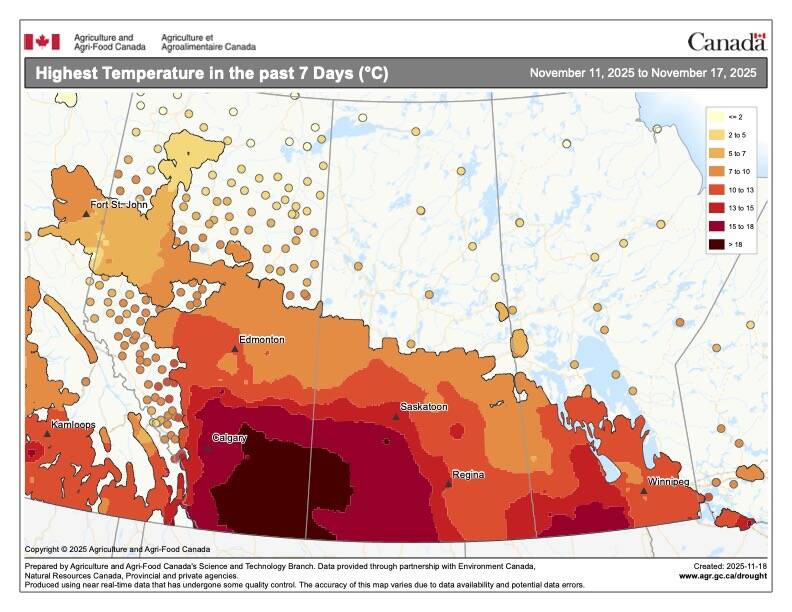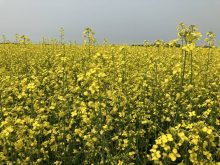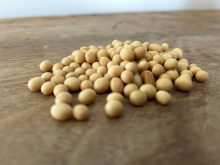Trevor Hadwen says recent snowfall in many parts of the Prairies is welcome, but is a “drop in the bucket” when it comes to rebuilding soil moisture reserves.
The agroclimate specialist with Agriculture and Agri-Food Canada’s National Agroclimate Information Service in Regina says a lot of the winter precipitation to date has been lost to the atmosphere.
“While Southern Alberta and much of Saskatchewan has received near normal winter precipitation, warmer than normal temperatures have reduced the snowpack, and increased moisture loss through evaporation and sublimation,” Hadwen wrote in a March 11 email. Bare soil through much of winter added to soil moisture loss.
Read Also

Is a weather station right for your farm?
Weather stations could make a great Christmas gift for the farmer in your life.
“Significant late winter snow and early spring rainfall will be needed to help kickstart the growing season with some much needed moisture.”
Given that scenario, farmers across the Prairies will look for ways to maximize yield and minimize risk when finalizing their 2024 plans. The following tips, though targeted at canola growers, can apply to other crops.
Bruce MacKinnon, technical services specialist with BASF in Lethbridge, says most farmers and experienced agronomists in the brown soil zone will be familiar with these tips, “but it’s a good refresher, and will be helpful for areas not prone to being dry.”
Fertilizer rates and placement
Pick realistic yields and fertilize accordingly, he advises. Balanced nutrition will reduce crop stress and can improve results in drought conditions. Recent research from Agriculture and Agri-Food Canada shows that adequate sulphur can improve results.
Hilltops often have lower sulphur reserves, so fields with blanket rates of sulphur may need a rate based on hilltop reserves.
Check for nitrogen rates deeper in the soil profile. A six- to 24-inch soil test will be particularly useful in fields with low moisture, says Mike Palmier, agronomist with Max Ag Consulting at Plenty, Sask.
“We have found over the last three or four years of drier conditions that our leftover nitrogen has been moving deeper and deeper into the soil profile with snowmelt and the odd rainfall. To be efficient with your nitrogen usage, it is important to sample down to a second depth.”
If reserves are high and crops do get moisture, tapping into these nitrogen reserves could reduce fertilizer cost per bushel.
As for placement, seed-placed fertilizer does more damage in dry conditions.
“Back off in dry conditions,” MacKinnon says. If possible, keep fertilizer out of the seed row.
Split fertilizer application is an option but involves the cost of an extra field pass. One strategy is to fertilize based on this year’s yield estimates, and use an in-season top up if yield potential increases significantly and soil nutrient reserves are insufficient to feed those yields.
Seed rates and placement
Set a canola seeding rate that results in five to eight plants per square foot. The lower end of the range may be appropriate in dry conditions, but don’t risk a thin stand.
“With only two or three plants per square foot, canola plants will try to fill the extra space with more branches,” MacKinnon says.
Side branches can mature later and slow dry-down, and make it more difficult to time operations, especially harvest. Waiting for thin stands to fill out also leaves more bare ground for weeds.
On the other hand, with a plant stand over seven plants per square foot, Palmier sees “increased inter-row competition between canola plants fighting with each other to pull up the moisture that they need.”
Marissa Robitaille Balog, agronomy specialist with the Canola Council of Canada, says canola emergence is often lower than anticipated in dry conditions, so factor that into the seeding rate. The rate and target plant density calculators at canolacalculator.ca may be useful.
Aim for a one-inch seeding depth, even if seed is not placed in moisture.
“Seeding deep to chase moisture can result in lower vigour, delayed emergence, uneven stands and more flea beetle susceptibility,” says Robitaille Balog.
And with deep seeding, rain can fill in the furrows and make seed depth even deeper. If seeding to reach moisture, place canola seed at the top of the moisture and pack well to prevent further moisture loss.
MacKinnon reminds growers to consider crusting risk in heavier soils, where rain before canola emergence could create a crust above the seed row. Working through the crust is more challenging for deep-seeded canola, he says.
Palmier recommends precision seeding tools that run between the stubble rows. This placement can reduce seedling mortality.
Insects and weeds
“If the canola crop has only five or six plants per square foot, you need to protect them,” MacKinnon says.
Keep on top of cutworms and flea beetles. Seed treatment protection only lasts so long, so scout to see if extra spray is required. In dry conditions, consider a flea beetle action threshold lower than the normal 25 per cent defoliation.
“The threshold in a thinner, dryer stand may not be the same as in an area with good rains and rapid growth,” says Robitaille Balog.
Weed competition takes up nutrients and moisture, leaving less for the crop. Control weeds while the crop struggles to establish.
Herbicide carryover is another risk. Canola is sensitive to Group 2 herbicide carryover. In dry conditions, the two major breakdown methods — hydrolysis and microbial degradation — will slow down, elevating the risk that these herbicides will remain active longer in the soil. Consecutive dry years increase the risk.
Planning ahead
Stubble management and cultivar selection can also improve crop results in dry conditions. Phillip Harder, research director and hydrological scientist with Croptimistic Technology Inc. and formerly with the Centre for Hydrology at the University of Saskatchewan, researched the relationship between stubble and soil moisture.
He found that in dry conditions, snow trapped in stubble and available to infiltrate in the spring doubles when stubble height is increased from 10 cm (four inches) to 20 cm (eight inches), for example. He says benefits increase up to about 30 cm (12 inches) of stubble height.
Residue spread also matters. Combines that achieve uniform residue spread across the full width of cut eliminate the need for a stubble-damaging harrow pass. Uniform residue spread improves seed placement.
Cultivars that yield consistently well in a broad range of conditions can lower risk when conditions are tough.
“Variety selection is huge,” Palmier says. In drought conditions, shorter plants with less biomass will often produce higher yields.
“High biomass looks best in June but usually yields the worst in dry conditions.”
MacKinnon says growers in the brown soil zone will often choose mid- to early-maturity cultivars that can beat the heat on flowering. Before making cultivar decisions for 2025, compare field trials and neighbours’ experiences this summer and check on final yields for those cultivars that look great in June.















